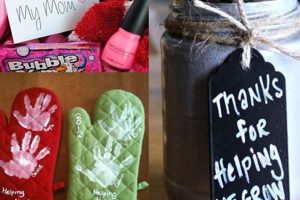The creation of personalized floral displays for the yuletide season allows individuals to express creativity and tailor festive decorations to specific tastes and home aesthetics. These handcrafted projects involve the careful selection and arrangement of various botanical elements and decorative accents to produce unique centerpieces, wreaths, and other ornamental pieces intended to enhance the holiday ambiance. For example, incorporating seasonal blooms like poinsettias, amaryllis, or evergreens, combined with ornaments, ribbons, and pinecones, can result in a bespoke Christmas arrangement.
The practice of crafting seasonal botanical displays offers numerous advantages, including cost savings compared to purchasing pre-made arrangements and the satisfaction of creating something unique. Historically, the use of evergreens during winter solstices symbolizes enduring life and hope, a tradition that has evolved into incorporating a wider variety of plant materials and decorative elements for Christmas celebrations. These handmade decorations foster a sense of personal connection to the holiday season and offer a tangible expression of festive spirit.
The following sections will explore different styles of seasonal floral displays, discuss optimal plant and material selection criteria, and provide step-by-step instructions for constructing several popular arrangements. Emphasis will be placed on techniques to ensure longevity of the creations, as well as guidance on adapting designs to suit individual preferences and available resources.
Tips for Crafting Festive Floral Displays
The successful execution of holiday-themed botanical creations requires attention to detail and a strategic approach. The following guidelines are intended to assist in producing visually appealing and long-lasting decorative arrangements.
Tip 1: Select Durable Plant Material: Prioritize evergreens such as fir, pine, and cedar for the structural foundation. These retain their foliage and aroma longer than more delicate options. Supplement with berries like holly or juniper for added color and texture.
Tip 2: Hydrate Plant Material Effectively: Employ floral foam that has been thoroughly soaked in water to provide continuous hydration to cut stems. Rehydrate the foam regularly to prevent wilting. For arrangements in vases, change the water every two days and add floral preservative.
Tip 3: Incorporate Complementary Color Palettes: While traditional red and green are common, consider incorporating silver, gold, or natural tones for a sophisticated aesthetic. Ensure the chosen colors harmonize with the existing dcor of the intended display space.
Tip 4: Utilize Proper Cutting Techniques: When harvesting or preparing plant stems, use sharp floral shears or knives to create clean cuts at a 45-degree angle. This maximizes water absorption and prevents crushing of the stem.
Tip 5: Secure Arrangement Components Effectively: Utilize floral wire, tape, or glue to firmly attach ornaments, ribbons, and other decorative elements to the plant base. Ensure that all additions are securely fastened to prevent accidental detachment.
Tip 6: Consider Scale and Proportion: The size and shape of the creation should be appropriate for the intended display location. A large centerpiece may overwhelm a small table, while a diminutive arrangement might be lost in a spacious entryway. Strive for balance and visual harmony.
Tip 7: Protect Surfaces from Moisture: When using vases or containers, place a protective barrier, such as a coaster or felt pad, underneath to prevent water damage to furniture or other surfaces. Regularly check for leaks and address any issues promptly.
Adhering to these recommendations will increase the likelihood of producing visually appealing and durable holiday arrangements that will enhance the seasonal atmosphere. Careful planning and execution are crucial for optimal results.
The subsequent sections will delve into advanced techniques for preserving botanical materials and exploring alternative design approaches for seasonal decorative displays.
1. Plant Material Selection
The careful selection of botanical components is paramount in the creation of durable and visually appealing festive arrangements. The choice of plant materials dictates the overall aesthetic, longevity, and thematic resonance of a floral display intended for the Christmas season.
- Evergreens for Structural Foundation
Evergreen branches, such as fir, pine, cedar, and juniper, provide the foundational structure for many yuletide arrangements. Their resilience to winter conditions ensures that the arrangement maintains its form and visual appeal for an extended period. The selection of a specific evergreen species can also influence the aroma of the arrangement, with fir and pine offering distinct fragrances. For example, a Fraser fir branch provides a denser, more compact shape suitable for smaller centerpieces, while white pine boughs offer a more cascading form ideal for mantel garlands.
- Berries for Color and Texture
Berries introduce vibrant color and textural contrast to otherwise predominantly green arrangements. Holly berries, cranberries, and juniper berries are frequently incorporated for their festive red and blue hues. However, it is essential to consider the toxicity of certain berries, particularly if the arrangement is to be displayed in a household with children or pets. Artificial berries offer a safe alternative while still providing the desired visual impact.
- Seasonal Blooms for Focal Points
While evergreens and berries provide the base and accent, seasonal blooms can serve as focal points within the arrangement. Poinsettias, amaryllis, and paperwhites are popular choices for their vibrant colors and seasonal availability. The size and placement of these blooms should be carefully considered to maintain balance and visual harmony within the overall design. Selecting blooms that are in bud form can also extend the lifespan of the arrangement.
- Dried Elements for Added Interest and Longevity
Dried elements, such as pine cones, seed pods, and dried flowers, can add textural interest and extend the longevity of the arrangement. These components are inherently durable and require minimal maintenance. They can also be sourced from natural environments, contributing to a more sustainable and eco-friendly approach to floral design. Spray painting dried elements in metallic tones can further enhance their visual appeal and complement a chosen color scheme.
The considered selection of plant materials is a pivotal aspect of the arrangement process, directly influencing its aesthetic impact and duration. Choosing components wisely allows for the creation of personalized Christmas floral displays that embody seasonal themes and maintain their visual integrity throughout the holiday period. Variations in element selection allows the user to adapt the arrangement to their specific aesthetic preference and create an individual approach to the design style.
2. Color Palette Harmony
In the context of crafting personalized floral displays for the yuletide season, harmonious color palettes significantly influence the overall aesthetic impact and perceived sophistication of the arrangement. The selection and arrangement of colors exert a direct influence on visual appeal, affecting the observer’s emotional response and the perceived quality of the completed project. A well-considered color scheme elevates a handmade arrangement from a simple collection of botanical elements to a cohesive and visually engaging decorative piece. For example, a monochromatic arrangement employing varying shades of green, from deep forest hues to lighter sage tones, creates a sense of tranquility and natural elegance. Conversely, an analogous scheme combining red, orange, and gold evokes a feeling of warmth and festive energy.
The application of color theory principles provides a framework for achieving visual harmony in these arrangements. Complementary color schemes, such as red and green, offer inherent visual contrast, but require careful balancing to avoid overwhelming the viewer. The use of a dominant color, supported by accents of its complement, often yields a more pleasing result. Furthermore, the integration of neutral tones, such as silver, gold, or natural browns, can provide visual relief and enhance the perceived vibrancy of the primary colors. For instance, the inclusion of frosted pinecones or silver ribbon in an arrangement dominated by red poinsettias and green evergreens softens the contrast and adds a touch of sophistication. Improperly balanced color choices can detract from the perceived quality of the display, leading to a disjointed and visually unappealing outcome.
Ultimately, the successful application of color palette principles requires careful consideration of the intended visual effect and the existing décor of the intended display space. While adhering to established color theory guidelines provides a valuable foundation, personal preferences and stylistic variations play a crucial role in achieving a truly personalized and harmonious result. The thoughtful selection and arrangement of colors transforms a holiday floral display from a mere decoration into a statement of individual creativity and festive spirit, resulting in an enhanced sense of satisfaction.
3. Arrangement Structural Integrity
Arrangement structural integrity, referring to the robustness and stability of a floral display, directly impacts the longevity and visual appeal of handcrafted Christmas botanical decorations. Without adequate structural support, even aesthetically pleasing arrangements can quickly degrade, diminishing their festive impact and negating the time and effort invested in their creation.
- Base Stability and Weight Distribution
The foundation upon which the arrangement rests is critical. A stable base, whether it’s a sturdy vase, a well-weighted floral foam block, or a secure wreath frame, prevents tipping and shifting. Careful distribution of weight, ensuring that heavier elements are placed lower and more centrally, further enhances stability. For example, using a wide, heavy ceramic vase for a tall evergreen arrangement will provide a more secure base than a lightweight plastic container.
- Secure Attachment of Elements
Individual floral and decorative elements must be firmly affixed to the base and to each other. Floral wire, hot glue, and strong adhesives are essential tools for securing stems, ornaments, and ribbons. Poorly attached elements can detach easily, disrupting the design and creating a haphazard appearance. Consider using wire to reinforce poinsettia stems that may be prone to drooping, securing them to stronger evergreen branches.
- Internal Support Systems
Larger or more complex designs may necessitate internal support structures to maintain their shape and prevent sagging. This can involve the use of hidden wire frameworks, wooden dowels, or strategically placed floral foam to provide reinforcement. For a large mantel garland, a wire mesh backing can provide the necessary support to prevent the garland from drooping under its own weight.
- Environmental Considerations
Structural integrity must also account for environmental factors such as temperature, humidity, and potential contact with passersby. Arrangements placed near heat sources, in high-traffic areas, or outdoors may require additional reinforcement and protection. Using weather-resistant adhesives and plant materials for outdoor displays, and ensuring adequate space around arrangements in busy areas, contributes to their long-term stability.
The careful attention to these structural aspects of floral design ensures that holiday displays maintain their visual appeal and stability throughout the festive season. Neglecting arrangement integrity can lead to premature deterioration, compromising the aesthetic effect and necessitating frequent repairs or replacements, thus diminishing the overall value of the festive decorations and the associated enjoyment.
4. Hydration Maintenance
Hydration maintenance is a critical factor directly influencing the longevity and aesthetic appeal of handcrafted Christmas floral displays. Insufficient hydration leads to premature wilting, discoloration, and eventual decay of plant material, undermining the time and resources invested in creating the arrangement. The effect of inadequate moisture is particularly pronounced in cut evergreens, which, unlike potted plants, lack a continuous root system for water uptake. This necessitates the implementation of strategies to actively replenish moisture lost through transpiration.
Effective hydration methods for these seasonal displays include the use of water-soaked floral foam, which provides a sustained reservoir of moisture for stem absorption. Regular replenishment of the foam’s water content is crucial, especially in heated indoor environments that accelerate evaporation. Furthermore, the addition of floral preservatives to the water can inhibit bacterial growth and enhance water uptake by plant tissues. A practical example involves incorporating a water pick, a small vial filled with water, directly into the stem of individual blooms, such as poinsettias, to ensure they receive adequate hydration independently of the main arrangement. Ignoring these practices results in a diminished lifespan for the arrangement and detracts from its intended visual impact.
Sustaining proper hydration requires consistent monitoring and proactive intervention. The challenge lies in maintaining a balance between sufficient moisture and preventing oversaturation, which can lead to fungal growth and stem rot. The integration of these hydration techniques is not merely aesthetic; it is fundamental to the economic and environmental sustainability of seasonal floral design. Effective hydration maintenance minimizes the need for frequent replacements of plant material, reducing waste and associated costs. Therefore, the emphasis on hydration as a key component in DIY Christmas floral arrangements is not only aesthetically driven but also promotes responsible resource management.
5. Personalized Thematic Integration
Personalized thematic integration, in the context of creating Christmas floral arrangements, represents the deliberate incorporation of individual preferences, family traditions, and specific design motifs to produce bespoke decorative displays. This element transcends mere aesthetic arrangement, reflecting personal narratives and enhancing the emotional resonance of seasonal decorations.
- Reflecting Individual Style
Personalized thematic integration allows for the expression of individual aesthetic preferences through the selection of specific flower types, colors, and arrangement styles. For example, an individual with a minimalist design sensibility may opt for a simple arrangement featuring a single type of evergreen and understated ornamentation, while someone favoring a more opulent aesthetic might incorporate a variety of vibrant blooms and elaborate embellishments. The chosen elements directly reflect the arranger’s personal taste, making each design uniquely their own.
- Incorporating Family Traditions
Family traditions often serve as a source of inspiration for personalized thematic integration. An arrangement may include specific ornaments or decorative elements that hold sentimental value, passed down through generations. The use of specific colors or flower types associated with family celebrations or memories further reinforces these connections. For instance, an arrangement might feature specific ribbon from grandma’s heirloom. This incorporation of familial elements transforms the arrangement into a tangible representation of shared history and cultural heritage.
- Aligning with Home Decor
Personalized thematic integration ensures that the floral arrangement complements the existing home décor. Considering the color palette, style, and overall aesthetic of the living space allows for the creation of an arrangement that seamlessly integrates into its surroundings. A modern home might benefit from a sleek, contemporary design featuring geometric shapes and metallic accents, while a more traditional setting may call for a classic arrangement with rich, warm colors and natural textures. Alignment with the existing dcor creates a cohesive and visually pleasing environment.
- Expressing Religious or Cultural Beliefs
Floral arrangements can be personalized to reflect specific religious or cultural beliefs associated with the Christmas season. Incorporating symbols, colors, or plant materials that hold particular significance within a given tradition adds depth and meaning to the display. For example, including candles or specific types of greenery associated with religious observances can transform a simple arrangement into a powerful expression of faith and cultural identity. A personalized thematic integration offers a method to celebrate cultural beliefs and express personal connection to the holiday.
The combination of these elements culminates in the creation of a Christmas floral display that transcends generic ornamentation, functioning instead as a personalized expression of individual style, family heritage, and cultural identity. Thoughtful integration of these themes adds depth, meaning, and emotional resonance to seasonal decorations, transforming a handcrafted arrangement into a cherished and symbolic element of holiday celebrations.
DIY Christmas Flower Arrangements
The following section addresses common inquiries regarding the creation and maintenance of handcrafted seasonal floral displays. These responses aim to provide clarity and practical guidance for achieving optimal results.
Question 1: What is the expected lifespan of a handcrafted Christmas arrangement, and how can it be maximized?
The longevity of a handcrafted Christmas arrangement varies depending on the plant materials utilized and the environmental conditions to which it is exposed. Arrangements incorporating evergreens such as fir and cedar generally last longer than those featuring delicate blooms. Hydration maintenance, including regular watering of floral foam and the use of floral preservatives, significantly extends the arrangement’s lifespan. Placement away from direct heat sources and drafts is also crucial.
Question 2: What are the potential hazards associated with specific plant materials, and what precautions should be taken?
Certain plant materials commonly used in Christmas arrangements, such as holly berries and poinsettias, are toxic if ingested. Arrangements should be displayed out of reach of children and pets. Handling of plant materials should be followed by thorough handwashing. The use of artificial berries or flowers may be considered as a safer alternative in households with vulnerable individuals.
Question 3: What are cost-effective alternatives to purchasing commercially available floral foam?
While floral foam provides a convenient medium for supporting and hydrating arrangements, alternatives exist for budget-conscious individuals. Moistened sphagnum moss, chicken wire, or even recycled materials such as damp newspaper can serve as suitable substitutes. These options may require more ingenuity in securing stems and maintaining hydration, but offer a viable cost-saving alternative.
Question 4: How can arrangements be adapted to accommodate allergies?
Individuals with allergies should exercise caution when selecting plant materials for arrangements. Fragrant blooms, such as lilies, are known allergens and should be avoided. Opting for hypoallergenic options, such as evergreens without strong scents or non-pollen-producing artificial flowers, minimizes the risk of allergic reactions. Air purifiers may also be used in the display area to reduce airborne allergens.
Question 5: What are the best methods for preventing needle drop from evergreen branches?
Needle drop, the shedding of needles from evergreen branches, can be minimized through proper hydration and the application of anti-transpirant sprays. These sprays reduce moisture loss from needles, extending their lifespan. Soaking evergreen branches in water before incorporating them into the arrangement can also help to hydrate the foliage and reduce needle drop. Avoid placing arrangements near heat sources, which accelerate needle drying.
Question 6: What are sustainable alternatives to traditional decorative elements such as glitter and plastic ribbons?
Traditional glitter and plastic ribbons contribute to environmental pollution. Sustainable alternatives include biodegradable glitter made from plant-based materials, natural ribbons made from cotton or burlap, and reusable ornaments crafted from wood or metal. Repurposing existing decorative elements is also a sustainable practice that minimizes waste.
The provided information serves as a general guide. Specific needs and circumstances may require further research and adaptation of these recommendations.
The next section will provide detailed step-by-step instructions for creating several popular types of holiday floral displays.
DIY Christmas Flower Arrangements
The preceding exploration has addressed essential aspects of crafting seasonal floral displays, from plant material selection and color palette harmonization to structural integrity, hydration maintenance, and personalized thematic integration. Each facet contributes significantly to the visual impact and longevity of the final creation, impacting the overall aesthetic and festive atmosphere. The process of developing bespoke seasonal decorations demands both technical knowledge and creative expression.
The principles and techniques outlined herein offer a foundational framework for individuals seeking to engage in the creation of personalized holiday arrangements. Continued exploration and experimentation will further refine these skills, enabling the development of increasingly sophisticated and expressive displays. Mastery of these skills translates into refined, personal expressions of holiday cheer and an enduring tradition of seasonal craftsmanship.







